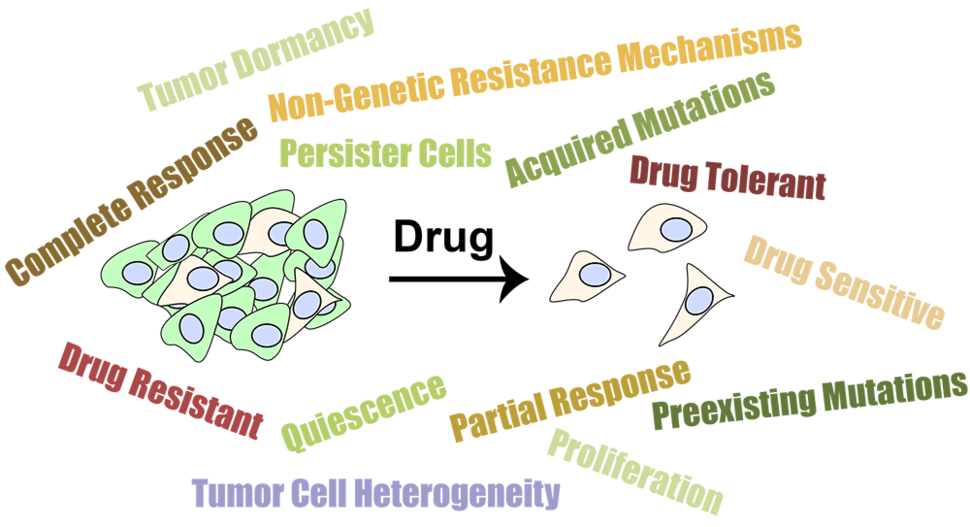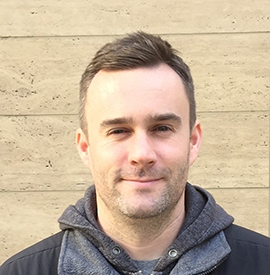Responses to Cancer Therapies are Complex
, by Matthew J. Hangauer, Ph.D.
Patient clinical responses and changes in tumor burden during treatment reflect the cumulative effects of diverse phenomena that occur at the cellular level. Therefore, it is useful to describe treatment responses at the level of patients, tumors and cells. Here, we will discuss the terminology that is used to describe the drug responses at each of these levels with a focus on heterogeneity between individual cancer cells.
Clinical responses for patients with solid tumors are judged based on changes in tumor sizes compared to a pretreatment baseline. Depending on cumulative changes across all measurable tumors, patients are judged to have a complete response (CR), partial response (PR), stable disease (SD), or progressive disease (PD). Each of these response categories apply to a single time point during treatment and can subsequently change. For example, a patient who experiences a CR or PR may subsequently relapse into PD. Also, distinct tumors within the same patient may respond differently. During treatment, tumors can undergo shrinkage, stasis, or growth. Tumors shrink if they are composed primarily of drug-sensitive cancer cells. However, a shrinking tumor may contain a minority of surviving non-proliferative or actively proliferating cells embedded in a larger population of drug-sensitive dying cells, giving the appearance of tumor shrinkage. Tumor stasis, or lack of change in size, can result from a bulk population of non-responsive and non-proliferative cells, an equilibrium state of dying and proliferating cells, or a mixture of these two scenarios. A related but not an identical term is tumor dormancy which is used to refer to cancer cells which disseminate throughout the body and remain undetected in microscopic groups or as single cells for months or years. These so called dormant “disseminated tumor cells” are thought to be the source of tumor recurrence in the cases where tumors reemerge years after cessation of therapy.
Individual cells within a tumor can have drastically different responses to therapy regardless of whether the overall tumor in which the cells reside is shrinking, static or growing. This cellular phenotypic heterogeneity can arise from genetic or non-genetic variations between cells. Drug resistance-conferring genetic mutations can preexist prior to treatment or can be acquired during treatment, and can cause resistance by activating, deactivating, or altering the structure of genes and pathways in cancer cells. DNA mutations are irreversible, and therefore if a cancer cell has a drug resistance-conferring mutation its daughter cells upon cell division will also be drug-resistant. This is a common and widely appreciated mechanism by which cancer cells survive
Alternatively, cancer cells can have variable drug response due to non-genetic mechanisms. Distinct from genetic mutations, non-genetic mechanisms of drug resistance are transient and reversible. The clinical observation of secondary responses in patients who have been treated with the same drug they developed resistance to, after a temporary period of time without treatment (drug holiday), supports the concept that reversible, non-genetic mechanisms of drug resistance play an important role in tumors. At the cellular level, emerging evidence indicates that a subpopulation of tumor cells can reversibly enter a non-proliferative (quiescent) “persister” cell state with decreased sensitivity to a range of cancer therapies. These persister cells are affected by drug treatment and stop proliferating, but do not die, hence they are referred to as drug-tolerant rather than drug-resistant. Persister cells have been found to have increased stemness, or capacity to regenerate new tumors, highlighting their potentially important role in tumor regrowth and dissemination after an initial therapeutic response. Recent evidence also indicates that persister cells have increased DNA mutation rates, possibly serving as a cell reservoir from which drug-resistant mutant cells with distinct mutations may emerge during treatment. If this occurs in patients, then a clinical approach to prevent the formation or elimination of persister cells before resistance-conferring mutations are acquired may be essential to achieve durable responses.
This discussion has focused on responses to small molecule drugs in solid tumors. Relative to our understanding of responses to small molecules, our understanding of the intricacies of responses to immunotherapy is at its infancy. However, it is likely that similar principles apply to antibody- and cell-based immunotherapies. Cell to cell genetic or non-genetic heterogeneity is likely to contribute to the emergence of drug-tolerant or drug-resistant cancer cells which are not recognized by or do not respond to effector immune cells. Therefore, continued efforts to characterize responses to therapy are important to identify approaches to overcome drug resistance and provide patients with durable responses from a variety of treatment modalities.

